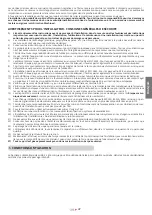
23
Control of the remaining protection and safety devices
Photocells: they can trigger both in opening as well as in closing; check the dip-switch programming. Clean the outer casing.
Check that the following specifications are respected:
• The flashing light is working and visible;
• The adhesive danger sign on the door is well attached and visible;
• The adhesive danger sign on the back of the barrier is well attached and visible. If these signs do not correspond to the stated
conditions, restore their original effectiveness or, if this is impossible, replace them.
FREQUENCY: every 6 months,
failing which the guarantee lapses
.
9. EXTRAORDINARY MAINTENANCE AND REPAIRS
ATTENTION: ON COMPLETION OF THE FIRST 2000 MANOEUVRES, THE ROD BALANCING PROCEDURE MUST BE CARRIED
OUT AGAIN.
If a complicated repair or replacement of electromechanical parts is necessary, the unit in question (control unit, gearmotor unit)
should be removed in order for the repair to be carried out by the manufacturer or by authorised technicians. Otherwise, the
safety and reliability of the barrier may be reduced (such as the guarantee for example).
If the barrier is used in a saline environment or an environment that is highly contaminated by corrosive chemi
-
cal reactants, the frequency of the maintenance controls must be increased due to the increased environmen
-
tal deterioration; In this case the external metal cabinet should also be inspected.
10. TROUBLESHOOTING
This paragraph deals with the most probable causes of common faults, in order to promptly re-establish the barrier.
In any case the indicated case study is incomplete (both from a cause point of view as well as a fault point of view).
a_ The barrier is blocked (open, closed or half-open):
1_ no power supply;
2_ inefficient commands;
3_ blown power supply fuse;
4_ photocells (also enabled during opening) active because they are incorrectly aligned and/or covered (grass, etc);
b_ the barrier continues to open and close;
1_ check the false contacts of the remote control buttons and the key selector switches that remain on;
c_ the barrier remains open;
1_ the photocells are active because they are not aligned and/or dirty (mud, etc) and/or covered (grass, etc);
d_ the barrier has difficulty in opening;
1_ the bar balancing spring needs adjusting;
e_ the barrier lifts/lowers more than the foreseen limits;
1_ the mechanical limit switches need adjusting (see chapter “MECHANICAL STOPS ADJUSTMENT”).
11.
DECOMMISSION
When the barrier has reached the end of its useful life it should be removed and the reusable materials should be recycled. Pay
attention to that which is stipulated by local and/or national laws and regulations. Care should be taken when recycling the fol
-
lowing parts:
• cabinet painted with epoxy paint
• methacrylate flashing light dome
• ABS control unit box
• electronic cards
• 12V dc dry battery (lead acid)
• lithium grease inside the reduction gear
• minor plastic and/or rubber connections and protections.
RESPECT THE ENVIRONMENT!
DISMANTLING WARNINGS: the barrier dismantling operations must respect the safety measures: therefore, disconnect the pow
-
er supply before proceeding. Slacken (not completely) the springs adjusting tie-rods so that the bar can be comfortably and safely
removed. Then unscrew the blocking screws on the base of the cabinet in order to process as desired.
12.
TRANSPORT
The bar, which can be purchased on request, is packed separately from the barrier that is packaged in a cardboard box.
Care and attention must be taken throughout the handling phase. Ideally, a manual or motorised trolley should be used for lifting
and movement. The items must be stored upright, even for short periods, respecting the direction that is indicate on the packag
-
ing and taking into consideration that high centres of gravity cause instability.
The bar must be stored making sure that there are no protruding parts or loads that could damage it. Once unpacked, make sure
that it is intact. Do not discard the packaging, but rather recycle it following local laws.
ENGLISH


































